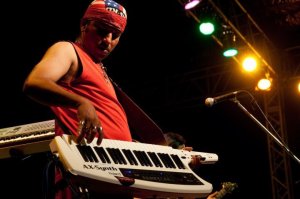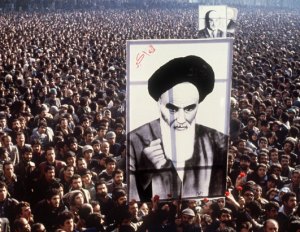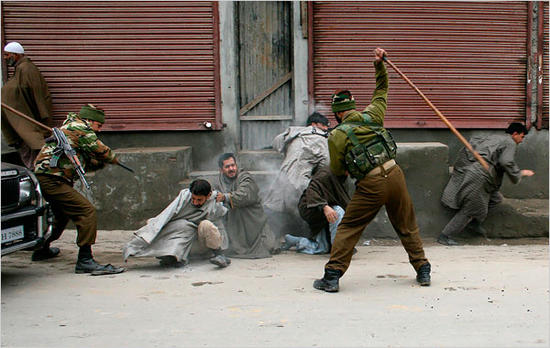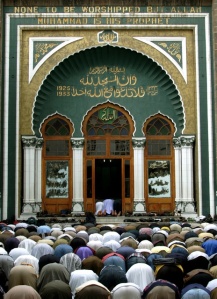Human rights and Indian minorities
November 21, 2011 Leave a comment
“You can hold yourself back from the sufferings of the world, but this holding-back is the only suffering you could be able to avoid”
_ Frank Kafka…
“Minority” is such a vague term. The permanent court of International Justice (PCIJ) in 1930 said, “ a minority is a group of persons living in a given country or locality, having a race, religion, language, and tradition of their own and united by this tradition of race, religion, language, and sentiments of solidarity, with a view to preserving their traditions, maintaining their forms of worship, ensuring the instructions and upbringing their children in accordance with the spirit and traditions of their race and rendering mutual assistance to each other”. This judgment of PCIJ became a starting point for the definition of a minority put forward by Professor Capotori in his report on the protection of minorities in 1977.
Article 25 of the Constitution of India provides for freedom on Conscience and free profession, practice and propagation of religion “subject to public order, morality, and decency and other provisions of course”. It has guaranteed right to religious and cultural freedom to all persons and groups as “sections of citizen” having a distinct language, script or culture of its own and minorities based on ‘religion and culture”.
The right to cultural freedom again constitutes one of the cornerstones of minority rights under Article 27 of International Covenant on Civil and Political Rights (ICCPR), under which Indian Govt is accountable to UN Human Rights Committee, to which it is required to submit periodic reports on its implementation.
The 1992 UN Declaration on Minority Rights goes beyond minority’s right to preserve its culture, language and script and puts the positive obligation on States to not only protect the national, ethnic, cultural, religious and linguistic identity of minorities but also requires them to create favorable conditions to enable minorities to express their characteristics and to develop their culture, language, tradition and customs”.
In India, the word “minority” is mostly used in the context of religious communities—Muslims, Christians, Sikhs, Parsis, Jews, and now Jains have also joined the fray. The Constitution of India has recognized religious minorities. Out of the total population of minorities, Muslims comprise the most percent, followed by Christians, Sikhs, Buddhists, Jains and others. India has world’s second largest Muslim population, with 135-40 million Muslims, only next to Indonesia.
Though Indian constitution offers equal opportunities of education, employment, political representation, but still most of the minority communities are at loggerheads since a long time now with majority community and with the state. Punjab situation in early 90’s, Babri Masjid-Ram Janambhoomi dispute, belligerent onslaughts on Christian Missionaries and desecration of Churches are some of the unfortunate events of our times that have contributed a great deal in tarnishing the image of India as a secular, liberal nation.
In fact this minority related dilemma is for all nations in South Asia. Bangladesh with Chakamas of Buddhist origin, Pakistan with Hindu and Christian minorities, Sri Lanka with Tamil minorities and Bhutan with Nepalese so on. Kashmir continues to a major cause of worry, a nuclear flash point, and the source of turbulence in entire region. Terrorist incidents are on rise. The minorities’ issue in South Asia is becoming further problematic because of the increasingly violent dimension that it’s acquiring in certain parts of the sub-continent.
The facts responsible for the denial of minority rights could be broadly divided into four categories: The ideological foundations of the states that promoted and maintained ethnic, linguistic, or religious superiority of the majority groups; the communalization of politics and politicization of religion; lack of awareness among the minorities about human rights and democracy and the ideology at political and social level.
Exploitation of the rights of minorities goes on several fronts. The rights of religious minorities, ethnic minorities, dalits, tribal, women, and children, poor and disadvantaged are frequently violated with utter disdain. Despite run-of-the-mill commissions set up to look after the interest of these specific groups viz, National Human Rights Commission (NHRC), Minority Commission, National Commission for Women (NCW), besides enacting of laws like Prevention of Atrocities Act 1989 to stop atrocities against Dalits and Tribal, and Prevention of Immoral Trafficking Act, Sati Prevention Act, Dowry Prohibition Act, despite all that, crimes against weaker sections of society and women haven’t ceased.
The Human Rights Committee of ICCPR while commenting on the report that India submitted before it in 1997 had noted with concern the continued severe social and political discrimination against national minorities, ST’s, SC’s, and OBC’s. It regretted the de-facto perpetuation of the caste-system entrenching the social differences. Discussing the status of women, the committee noted—under-representation of women in public life, religion based personal laws violate the right to equality of women. The injustices perpetuated against lower caste people (Dalits) are not merely social but also economical. They have been victims of discrimination in the sphere of education and employment for centuries. Prime factors responsible for it are—socio-economic structure, various legal measures and to top it all, the lack of political will. The caste system is a social bane. NHRC has aptly termed it a “historic wrong”.
Newly emerging human rights groups have now raised another problem, namely the problem of the rights of Indigenous people. Indigenous people are also called ‘first people’, ‘tribal’, ‘aboriginals’, ‘autochthons’ etc.
They number around 300 million in over 70 countries on 5 planets. As per Human Rights Watch report, Dalits and Indigenous people (ST’s or Adivasis) continue to face discrimination, exclusion, acts of communal violence. It says laws and policies adopted by Indian Govt provide a strong basis for protection, but are not being faithfully implemented by local authorities (India Events of 2007—Human Rights Watch). Amnesty International in its report says, ‘it’s the responsibility of Indian Govt to fully enact and apply its legal provisions against discrimination on basis of caste and creed (India Unfinished Agenda: Equality and Justice for 200 million victims of caste-system, 2005).
Notwithstanding Article 19 (5) of Indian Constitution giving them right to move about freely, settle in and acquire property, they are still a deprived lot. The forest dwelling tribal population has not only lost their land, but also their livelihood. It’s an irony that the rich natural resources and mineral wealth of tribal areas is prime cause of land alienation among tribal people. Govt on the pretext of development and modernization is displacing them from their lands, resulting in their starvation. Sarguja in M.P, Kalahandi in Orissa, Palamu in Bihar, Soubhadra in U.P, Dhulia in Maharashtra to name a few.
In Dec 1993, the United Nations Convention on Elimination of Discrimination against Women was adopted. It strictly prohibits violence against women, and calls for universal application of the rights and principles with regard to equality, security, liberty, integrity and dignity of all human beings. But despite that, women have been up against worst kind of hardships. They have been killed, tortured, raped, harassed, ill-treated, and taken hostage by groups representing extremist ideologies, and even those having official sanction.
Children are also the victims of rights violations. Child labour continues to be menacing concern in this country. The minimum age for child labour in Indian Child Labour Act is 14 years, slightly lower than ILO’s 15-year bar. But still innumerable children keep toiling hard below that age, forced to do demanding and backbreaking labour.
There is no agreement on the magnitude of child labour in India. The carpet industry in Mirzapur, glass factory in Firozabad, match and fireworks industry in Sivakasi, gem polishing in Jaipur and Surat, brassware units in Moradabad, carpet manufacturers in Kashmir, and lock industry in Aligarh are some sectors where the incidence of child labour is quite high.
It is caused by an inequitable economic system that ensures all does not share the benefits of economic growth. As Justice P.N Bhagwati says, “It’s not result of widespread poverty, but one of the factors which perpetuate poverty” (Gathia, Joseph 1992, “Analytical Study of Child Labour” Centre of Concern for Child Labour, New Delhi). Amnesty International have slammed India’s human rights record on following two grounds—First is the violation of human rights by troopers in so-called “disturbed areas” like Kashmir and North-east and secondly the widespread violation of children rights due to child labour.
Even Human Rights watch world report 2007 criticizes India saying, “The leading human rights concerns in India include the failure to implement policies that protect the rights of children”. But the problem for children doesn’t stop at child labour. Despite much hyped scheme launched two years ago to provide universal education, millions of children in India still have little or no access to education. India accounts for a significant proportion of the world’s dropouts. This is because most children belong to deprived communities, marginalized sections have to make choice: to work for living, or to die of starvation.
The serious issues of child trafficking are also on upswing. But more disturbing is how innocent, hapless children are being exploited by vested interests. It is pertinent to note that in Chattisgarh state, children are being made to participate in the violent activities. All parties to the conflict, including Indian Govt and the Naxalites in taking on each other in no-holds-barred clash, are using them as pawns.
A Human Rights Watch report on the Chattisgarh Conflict—“Dangerous Duty: Children and the Chattisgarh Conflict 2007” presents a clear picture as how the two parties in conflict are exploiting children, and how the conflict is taking toll on these children a and how it is adversely affecting their education. The report is based on information gathered from over 160 interviews with villagers, Salwa Judum camp residents, police SPO’s and former child Naxalites in Chattisgarh state. Joe Baker, a children rights activist for Human Rights Watch notes in the report, “A particular horror of Chattisgarh conflict is that children are participating in the violence. It’s shameful that both India’s govt and the Naxals are exploiting them in such a dangerous fashion”.
But when the topic veers to religious minorities in this country, human rights discourse turns on its head. By the definition given by UN Convention on Prevention and Punishment for the Crimes of Genocide, India is the only democracy in world of having treated its minorities to not one but four genocide killings in the time span of 18 years. Delhi (84), Bhagalpur (87), Bombay (92), Gujarat (02). Sikhs were the targets in first, and Muslims were the targets in rest of three. Now recently, Christians also came under the receiving end of ring-wing Hindutva fanaticism in Orissa, Karnataka and Kerala and M.P. So we can say, minorities in this country continue to live on the edge, even after 60 years of Independence.
But if we muse back into past, we see that the communal clashes in this country have been prevalent from around the time of independence. Among the oldest incidents of communal violence in India was Moplah rebellion, when suspected Muslim militants massacred Hindus in Kerala. During partition, worst communal riots broke out during which large numbers of people from either of communities were brutally mowed down in large-scale violence. Then after a brief lull, there was a storm again in 1984 in the shape of anti-Sikh riots, staged and sponsored by secular-centrist Congress Party of India, post Operation Bluestar and cold-blooded assassination of Indira Gandhi by her Sikh bodyguard. In the 4-day period of riots, some estimates say around 2000 were killed (Nicholas Burns, ‘Politics of Assassination: Case Studies and Analysis’). The most affected regions were neighborhoods in Delhi.
There are serious allegations that it was organized by State and so Govt later destroyed evidence and shielded the guilty (Swadesh Bahadur Singh, ‘Cabinet berth for a Sikh’ Indian Express 3 Mar 96). The Asian Age carried a front-page story calling govt action “Mother of all Cover-ups” (Seema Mustafa, 03 May 96). Ten commissions and committees have so far inquired into the riots and many of the accused were acquitted or never charge-sheeted. Latest report of Nanavati Commission was submitted in Feb 2004. It claimed evidence against Congressmen Jagdish Tytler, Sajjan Kumar, H.K.L Bhagat for instigating the mobs to violence. It also held then police commissioner S.C Tandon directly responsible for the riots. It was a gruesome carnage engineered against Sikhs. As India Today wrote, “Criminally led hoodlums killed Sikhs, looted or burnt homes and properties while the police twiddled their thumbs (Nov 15, 1984). Even noted author Khushwent Singh, a close confidante of Mrs Gandhi says that he felt “like a refugee in my own country, in fact like A Jew in Nazi Germany”.
Dev Dutt, a Delhi journalist recounts the gory scenes of that afternoon, when “communal riots flared through the capital. Mobs of young men on motor cycles burnt, raped and pillaged the pre-dominantly Sikh areas of city The shops run by Sikhs were razed to ground Police either did nothing or egged the protestors on” (mytholyoke.edu).
Harvinder Singh Pholka, man behind Citizens Justice Committee fighting for the 84 riot victims says the pitiable saga still continues, as “victims are victimized in courts too”. He believes judiciary actively supported a cover-up, saying “All cases were not registered; many of those registered were closed by the police and did not reach the courts… Also there has not been exhaustive inquiry on who is responsible and how all this happened” (Times of India archives 2004).
Josy Joseph writes, “The police looked the other way round as the politicians led marauding mobs into the city”, further adding that it was an “organized massacre of minority community by politicians and their supporters”. (TOI archives, 2004)
But the saga continued. It was followed by anti-Muslim riots in Bhagalpur (87) and Mumbai (91-92). The latter took place after the demolition of Babri Masjid and subsequent serial blasts. About 1000 people were killed during the course of riots, mostly Muslims. As a result, large number of Muslims was forced to migrate from Hindu-majority areas to Muslim-majority areas, drastically changing the demographics of city on religious lines. Lakhs of others migrated to other relatively safer states like UP.
Majority of victims fell prey to utterly atrocious acts like stabbing, mob brutality, physical assaults, loot, arson, and shootouts. Property worth crores was razed to pits. Farah Baria elaborates, “Not the cold, impersonal genocide of terrorism, but vindictive, visceral violence of loathing that turns neighbors into butchers and friends into murderers” (Indian Express 31 Aug 07).
Maharashtra police was literally given the free run, as Govt and law-enforcement agencies stood paralysed. Political bigwigs like Shiv Sena supremo Bal Thackeray, then CM Manohar Joshi, BJP leader Gopinath Munde, were fully throwing their weight behind the rioters, as Sri Krishna Commission report revealed. Farah says, “then to add insult to injury, the “Muslim” bomb trail was conducted in a high-profile TADA court, while the “Hindu” riot trail was quietly consigned to a commission of inquiry—that classical Indian euphemism for official stonewalling” (Indian Express 31 Aug 07).
Sri Krishna Commission report implicated Shiv Sena and its leadership for the bloody mayhem. It put blame squarely on its chief Bal Thackeray. Report says, “Thackeray like a veteran general commanded his loyal Shiv Sainiks to retaliate by organising attacks against Muslims”. But then CM and Thackeray’s ‘Man Friday’ Manohar Joshi had blatantly opted to resign than take action against his mentor. So expectedly, the report was swiftly shelved by the Govt and even later by successive govts, fearing the alienation of Hindu vote bank. Chaggan Bhugbal, who was the leader of opposition in Maharashtra when the report was tabled, had categorically refused to agitate on the report, recalls Jyoti Puniwani, “What do you expect? I punish every policeman, and make force my enemy?” Bhugbal had said. (Times of India 07 Aug 07).
When Congress govt came into power, it promised the implementation of the report and justice to riot victims, but it only proved eyewash. The report has been gathering dust for over a decade now. It’s amusing to note that while 100 “Muslim” accused were brought to book for the heinous murder of 257 in the Bombay riots case, not even a single person has been convicted in connection with Bombay riots case. Double standards indeed.
Gujarat was the next stop. Following the Godhra train fire that claimed 57 lives of Hindu pilgrims, over a thousand Muslims were mowed down in cold blood by angry mob (Human Rights Watch, 2006). And as Ashish Khetan says, “in its aftermath, more than 2000 people, many of them women and children were massacred and thousands rendered homeless in one of the Independent India’s worst communal pogroms” (Tehelka 11 Oct 08). Gujarat CM Narendra Modi had rather brazenly justified the bloodbath as a ‘natural’ reaction to the events at Godhra, thus confirming official sanction to the carnage. It was by all accounts and evidences a state-managed pogrom, executed by Saffron fanatics led by VHP, RSS, Bajrang Dal, at the behest of people in higher echelons of power led by C.M himself. Hence Modi govt had to do everything to bury the truth under layers of lie, obfuscation and fabricated evidence.
A one-member Commission of Justice K.G Shah formed by Gujarat Govt on 06 Mar 02 was later turned into two-member Commission with Justice G T Nanavati as its chairperson. Both of them had obviously got the briefs from Govt, and they acted accordingly. And little strange, its report released recently turned out to be a “bundle of lies”, giving a “clean chit” to Modi Govt for their connivance in riots. Tehelka investigation had already blown the lid off the entire thing. Its tapes raised serious questions over the impartiality of the Nanavati-Shah Commission and of its two members. In a disturbing statement, the Gujarat Govt’s special prosecutor Arvind Pandya had told Tehelka under-cover reporter that Justice Shah was “BJP Govt’s man” and Justice Nanavati “was only after money”. That explains everything.
Amusingly enough, while dishing out report, Commission neither summoned the report nor examined the Tehelka tapes and even failed to initiate inquiry into the revelations of the tapes.
In Sept 04, Railway Ministry instituted a second Commission of Inquiry under Justcie U C Banerjee, who in a speedily concluded report, stated that the fire in coach 6 was “accidental”. And, as noted human rights activist and Journalist Teesta Setalvad says, “It becomes a sordid justification for unleashing the post-Godhra carnage across Gujarat” (Tehelka 11 Oct 08).
“Once Gujarat happened, the reaction of the state govt was painfully slow. Was it slow or was it kept deliberately slow? It took no measures worth the name,” notes A N Dhar (Narendra Modi’s Gujarat in M L Sodhi and Apratim Mukherji ed “The Black book of Gujarat”). Justice J S Verma who headed NHRC during the Gujarat carnage says, ‘The very first intervention of NHRC in March 02 clearly suggested that both police and highest functionaries of state govt were inactive in protecting its people” (Tehelka 11 Oct 08). He says Vajpayee could have intervened but he didn’t. Gujarat, post-Godhra and protracted communal carnage that followed has become a place of deep communal polarization. Muslims in Gujarat continue to live in fear.
Furthermore, Muslims in this country allege discriminatory treatment both from Govt as well as from mainstream media. They have been stereotyped as anti-nationals and renegades by the media. Gen secretary, Muslims for Secular Democracy, Javed Anand says, “When our investigation agencies say Pakistan’s ISI or LeT, Bangladesh’s Jihad-e-Islami, SIMI, or Indian Mujahideen is suspected of being responsible for blasts in one city or other, its considered (rightly so) and is displayed prominently on front pages. But when anti-terrorist squad of Maharashtra Police, not merely suspects but after investigation files charge sheet in court accusing “Bajrang Dal” activists of engaging in “terrorist acts” with covert logistical support from other wings of Sangh Parivar, that is not news” (Times of India 24 Sept 08).
The other minority community that has been in the line of fire is Christians. They have suffered equally worst in the course of history at par with Muslims or Sikhs. They have been called ‘traitors’, ‘thieves’, and ‘second class citizens’. (M S Golwalkar ‘We or our nationhood defined’ in A G Noorani “RSS and Christains” Frontile 1 Jan 99).
The hallmark of Christianity, contrary to widespread perception, is love-personified. Contrary to wild and cheap allegations levelled by Hindutva hoodlums, Church doesn’t engage in forced or mass conversions, rather its missions scattered across the country run orphanages, hospitals, schools, homes for old and disabled. But still they have been accused of brainwashing Hindus into converting to Christianity with monetary allurement—an outlandish and exaggerated charge of course. They have come under attack from Hindu extremists on several occasions.
It may be recalled how on Christmas Day in 1998, Christian institutions including 37 churches were brutally attacked by right-wing activists, ostensibly with the backing from power corridors. The Home ministry informed Lok Sabha on 28th Aug 2001 that there were 417 attacks on Christians in India since 1999 in which 33 were killed and 283 injured (Free Press Journal 2 Sept 02).
Very recently, Christians had to again relive the nightmare in Orissa, Karnataka and Madhya Pradesh. Since August 08, reports of attacks on Churches and Christians in different parts of these states have been flying flick. The rise of attacks especially in Karnataka has coincided with the coming to power of BJP Govt, which is ideologically aligned with RSS. K L Ashok, Secretary of Karnataka Communal Harmony Forum talking to Tehelka said, “The conversion debate and all questions of forceful conversion are unsustainable arguments. The constitution gives everyone the right to practice, profess, and propagate religion. Besides why doesn’t the law of land apply? Why not register police complaints against those who indulge in ‘forcible’ conversions? They have no evidence, nothing to hold against Christian community” (Tehelka 04 Oct 08).
The impact on Christian and Muslim minorities due to the spread of communal venom and rapid communalisation of politics is far glaring and perilous. If the wisdom doesn’t prevail now among those holding power and if the fanatics on prowl are not reined in, consequences can be ominous for India’s great age-old secular-liberal traditions.
As Martha Nussbaum notes, “In the case of India, the threat to democracy comes not from any clash between European and Non-European civilizations but from something much more sadly familiar: a romantic European conception of nationalism, based on ideas of blood, soil, purity and the Volksgeist” (The Clash Within, Permanent Black, 2007).













Recent Comments